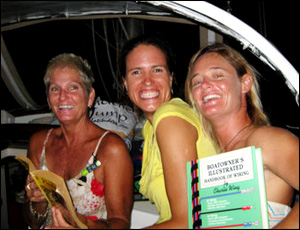Bev Feiges wrote the following for us after reading Galley Advice from 18 Cruising Women on the Women and Cruising website. In that article, we asked 18 cruising women to describe their galley for us, and tell us what they considered essential aboard. Although several of the 18 women participating in our article have generators aboard, and a number have some electrical appliances, none have a truly “electrical galley” as Bev does aboard her power boat. Thanks, Bev, for sharing your experience with us. – Kathy Parsons
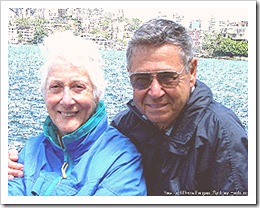 I just read most of the interviews of the 18 women and their galleys, and I was so surprised not to hear one person, including the woman on the 68 foot motor boat, speak up for an electric galley, or having a generator. You may not want to hear the other side of the story, but I feel someone should make the case.
I just read most of the interviews of the 18 women and their galleys, and I was so surprised not to hear one person, including the woman on the 68 foot motor boat, speak up for an electric galley, or having a generator. You may not want to hear the other side of the story, but I feel someone should make the case.
We started our cruising life aboard my parent’s sports fish, cruising, and fishing the Florida Keys, and the Bahamas. I can’t think of a boat of this type that isn’t equipped with a generator, because they will have freezers and refrigeration, (necessary to keep the bait and the fish you are going to bring home with you) and in those climates, where you spend your time in marinas, even air conditioning is essential.
We would get to the marina, fuel up – they burn a lot of fuel- go to the dock and plug in, so we could turn the generator off, and also connect the hose, since the whole boat was scrubbed down every night. Being in a marina in the tropics was usually hot and buggy, so the air conditioning was also turned on, and we ate, and slept in comfort.
This certainly had its impact on our want list when we finally decided to buy our first cruising sail boat in 1977. We knew we wanted air conditioning, which would necessitate a generator, we knew we wanted a freezer, (freezing food is my husband’s business), and with a family of five kids, I didn’t want to have to eat canned foods while sitting in remote anchorages, with no grocery around.
We bought a Cal-46-3, and it came with all these things. It had a microwave, a propane gimbaled stove, a single sink with a large stainless drainboard, a combination chest-type frig and freezer. All of this fitted into the passageway leading to our back cabin. No worry about being thrown anyplace. We immediately put a port above the sink, so we could pass food up to someone sitting in the cockpit, and dirty dishes could be passed down to the man at the sink. Shortly thereafter, we made a separate freezer, twice the size of the original.
In 1989 we brought the boat back from the Caribbean to Florida, and “geriatricized” her. Included in the changes was removing the old microwave, which took up all the space to the left of the sink, and the gimbaled stove, which burned the bottom of everything baked in the oven before it would bake the top half, and was impossible to clean behind. Instead, we put in a two burner electric cooktop, gaining all the space below for a garbage pail cupboard and a tray cupboard and a drawer for utensils. Above the burners we put a combination microwave/convection oven, and where the old microwave was I gained another cupboard and a lot more counter space.
That galley worked great, and we never missed searching for, and lugging back propane bottles, in out of the way places. This worked for the next ten years, and we repeated the formula, when we outfitted our much smaller live-in horse trailer, except we went back to propane for the cook top, since everything, including the generator and refrigerator ran off propane. But then we had two very large bottles, that we drove to the fill up places.
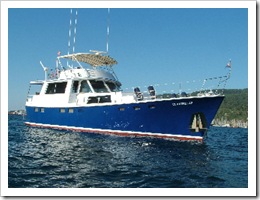 When we bought our second boat, a 60 foot motor boat, it came with household appliances from Sears, stove, microwave/convection oven, toaster oven that can bake or broil, dishwasher, trash compactor, and disposal, and of course, they were all electric.
When we bought our second boat, a 60 foot motor boat, it came with household appliances from Sears, stove, microwave/convection oven, toaster oven that can bake or broil, dishwasher, trash compactor, and disposal, and of course, they were all electric.
We have a large refrigerator/freezer, (16 cu. ft.) in the galley, and another freezer in the saloon, (6 cu. ft.), where the former owner had an ice maker and a compartment he hoped would stay at freezing from the spill over. The idea didn’t work; we turned it into a total freezer.
Because of our inverter, we can run everything except the stove, one appliance at a time, and if we don’t want to start the generator to use the cooktop, we have a single electric plate, that Dave says someday he will mount in one of the four burners on the stove top, since I never use all four. It’s against my work ethic.
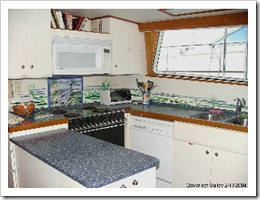 All the refrigeration runs off the batteries, and only consumes about 100 amps a day. We are able to run all of this, along with all the other electrical items we are used to having in a our homes ashore, by running the generator between two and three hours a day. We spend about 95 percent of our time at anchor.
All the refrigeration runs off the batteries, and only consumes about 100 amps a day. We are able to run all of this, along with all the other electrical items we are used to having in a our homes ashore, by running the generator between two and three hours a day. We spend about 95 percent of our time at anchor.
Have we had trouble keeping it all going? Like everything in the cruising life, if you have the skills to “fix” things, there is no problem. In 32 years of cruising, we had two days without the generator in our first year, and half a day with the second boat.
For Dave, who never really liked walking beaches, looking for shells, fixing things was his passion. Once he said to me, after weeks of nothing going wrong, “If something doesn’t break pretty soon, I’m going to be bored to death.”
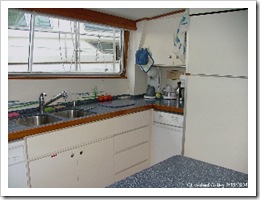 Our galley, note the size of the fridge and freezer, designed for people who live in the mountains off the grid. On the other side of the galley you can’t see, is a table and L shaped settee, where we can easily sit six, and we have crowded in 8. We can sit 8 to ten in the salon, where the table pictured flips open to seat 8 to 10, and on the back deck is another table that nicely seats six. We are equipped for lots of entertaining, and we do it.
Our galley, note the size of the fridge and freezer, designed for people who live in the mountains off the grid. On the other side of the galley you can’t see, is a table and L shaped settee, where we can easily sit six, and we have crowded in 8. We can sit 8 to ten in the salon, where the table pictured flips open to seat 8 to 10, and on the back deck is another table that nicely seats six. We are equipped for lots of entertaining, and we do it.
So please, don’t scare every would be cruiser into thinking they must give up life as they know it, if they can afford to do otherwise.
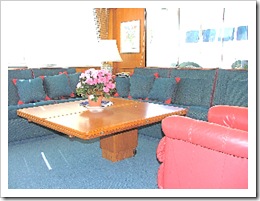 In a small boat, a combi microwave convection oven still takes up less space than any kind of full stove, and can be run off an inverter. I use my microwave more than any other method of cooking.
In a small boat, a combi microwave convection oven still takes up less space than any kind of full stove, and can be run off an inverter. I use my microwave more than any other method of cooking.
You also made no mention of things like slow cookers, or the old electric fry pan, which again can be run with an inverter off the batteries, which can be charged with wind or sun if you don’t want a generator.
Even generator technology has improved so there are very small, very quiet ones, that almost anyone can fit on a boat. There are just so many things happening right now in the technology field, that even we are old fashioned, but to me, reading about the galleys you featured was like stepping back in time, a time before even our first boat came on the market.
About Bev
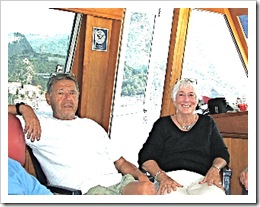 After a quarter century of sailing and racing fast, mostly Inland Lakes Scows we switched to a Cal-46-3 sail boat in 1977, what you might call a life defining moment. And what a life it was.
After a quarter century of sailing and racing fast, mostly Inland Lakes Scows we switched to a Cal-46-3 sail boat in 1977, what you might call a life defining moment. And what a life it was.
We sailed for 21 years, never letting grass grow on our keel, until I said one day, “Life on the slant isn’t fun anymore.”
I was just too creaky in the joints to continue to enjoy it, but remove the slant, make it more comfortable, (you might think of it as an old folks home for cruisers) and we were able to continue doing the parts we loved.
We moved aboard our second cruising boat, a 61 foot custom Krogen design, and we have been living full time aboard since 2002. We have no other home than the boat, and so far, it is still as good as it gets.
I would put ourselves in the category of “coastal cruisers”, which allowed us to cover the entire eastern seaboard from Grand Manan, Canada, to half the western coast of Florida, all of the Caribbean excluding Cuba, from Hispaniola, (both coasts of the Dominican Republic) through all the islands and the coast of Venezuela as far west as Bonaire, and Honduras, Belize, Guatemala, and Mexico in the western Caribbean.
Since I am a coastal cruiser, and want to see it all, and since my motto has been, “Never, never sail at night, always keep the land in sight,” we have probably anchored more times that most people who have circumnavigated.
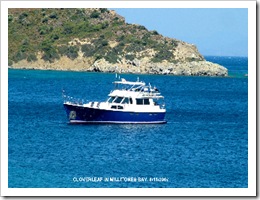 We covered a lot of the Med, from the Balearics to Turkey, and south along the coast to Egypt, through the Suez Canal, as far south as Abu Tieg. We spent five summers and three winters in the Med, but of course, Dockwise took care of the ocean crossings.
We covered a lot of the Med, from the Balearics to Turkey, and south along the coast to Egypt, through the Suez Canal, as far south as Abu Tieg. We spent five summers and three winters in the Med, but of course, Dockwise took care of the ocean crossings.
Now that I am older and much lazier, and not experiencing the joys of sailing, I find it easier to do some of those longer jumps, say 36 to 48 hours, rather than plowing up the ICW, but I am very careful about the sea conditions when passage planning. I saw the injuries our older sailing friends had, from that instability we all have happen as we age, and I am doing my best not to let it happen to me, or Dave.
Bev and Dave Feiges
Aboard Cloverleaf
Chesapeake Bay
Read also on this website
- Galley Advice from 18 Cruising Women
- Bev’s contribution to our article “Refitting the Galley: 12 Experiences”
- To Have or Have Not? (Admiral’s Angle column #31)
Equipping your boat with an eye to striking a balance between simplicity and complexity - The Cruising Galley ((Admiral’s Angle column #35)
When cruising, meals suddenly matter again, and, for many, cooking becomes a pleasurable adventure rather than a stereotypical chore.
More info
- Read Bev Feiges’s blog, “Cruising with Cloverleaf“

